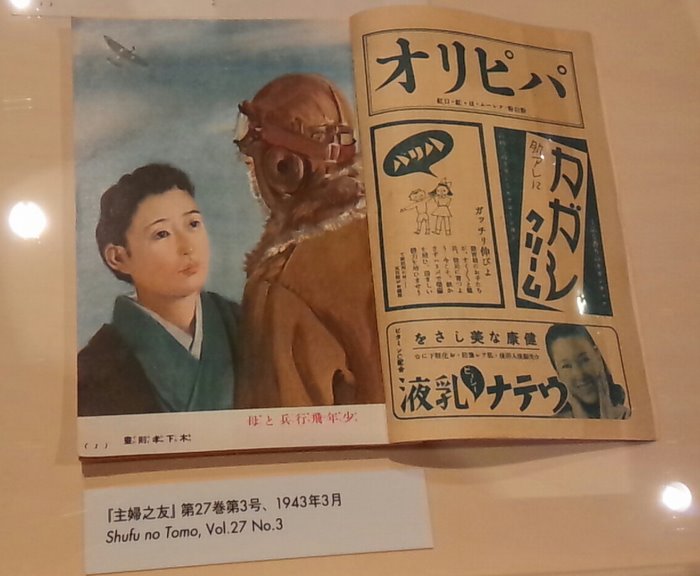
"Young Fighter Pilot and Mother"
The National Museum of Modern Art, Tokyo 1 is referred to as MOMAT, and I have often confused it with the similarly-abbreviated Museum of Contemporary Art, Tokyo 2, known as MOT. Perhaps some of this confusion has arisen due to the strange position of the word “Tokyo,” which never seems to sit comfortably in either name. Perhaps it is simply due to the fact that the abbreviation “MOT” glosses over the two words (“Contemporary” and “Art”) that would help to distinguish it from Tokyo’s other myriad Museums. In order to avoid any confusion I have often referred to MOMAT and MOT by the names of their nearest train stations (Takebashi, Kiyosumi-Shirakawa). In any case, given the impressive way that MOMAT has revamped its permanent collection, I am confident that I won’t have any such trouble remembering it in the future.
The museum itself says that its collection is not so much revamped as “Reborn!” 3, and I think the results warrant such excitement. Before this rebirth, I would sometimes visit the collection’s photography section to see some modern masters, but there were no links to other galleries; each room was its own isolated world. Now, the rooms are ordered chronologically and connected by a clear story which performs the valuable service of explaining the development of modern Japanese art. Surprisingly, this story is built around Japan’s participation in World War II. The jargon-free wall text (designed by Kazunari Hattori of Osiris 4 fame) situates the works in light of Japan’s modernization and militarization, and does not shy away from explaining pro-expansionist allegories when they exist. Panels at the entrance to each room give the viewer a rough idea of the cultural and political situation around that time.
The room of wartime material is particularly impressive. Two large-scale, bombastic paintings hang on one wall. These paintings (one of which shows the infamous Battle of Saipan 5 in a heroic light) were confiscated by US troops after the war, but they are currently on “indefinite loan” to Japan under the terms of an agreement negotiated in the 1970s; MOMAT was entrusted with their restoration and preservation. A painting that offers a veiled criticism of the war hangs on the other side of the room, while women’s magazines during the war sit in a vitrine in the center. Almost as a rule, museums in Japan tend to avoid touching on Japan’s military history, so it really is unusual for a major institution like MOMAT to address this topic with such frankness. I wonder if MOMAT will lead from the front in this regard.
In any case, I am happy to see the museum making such an effort to communicate clearly with its viewers, rather than throwing some works together and connecting them only with opaque explanations—or not connecting them at all. My understanding is that the permanent collection will remain more or less intact, with only the later rooms changing to complement the museum’s special exhibitions; when I went last week, Josef Koudelka was showing upstairs, so these rooms were showing other work from Eastern Europe. Obviously I highly recommend a visit to the Reborn! permanent collection. Keep in mind that it’s free on the first Monday of each month!